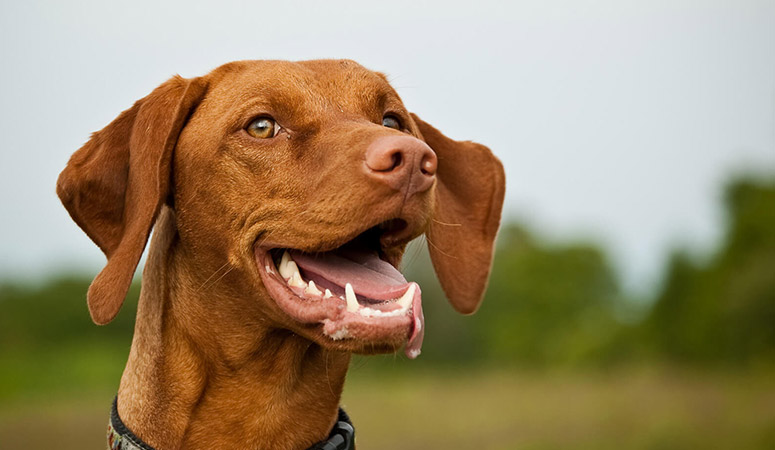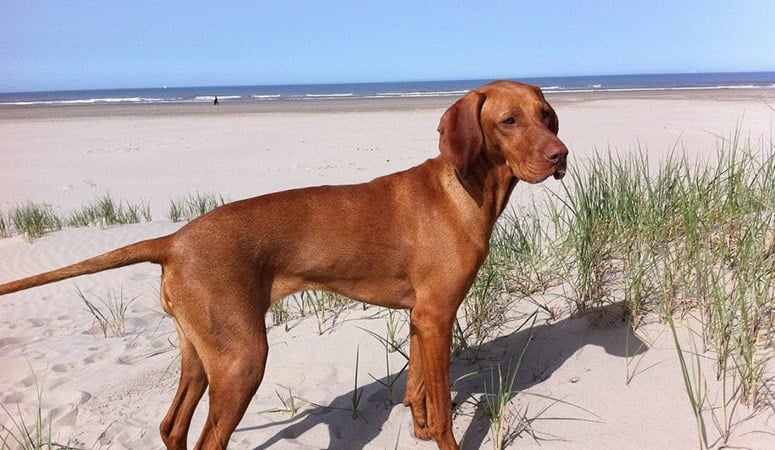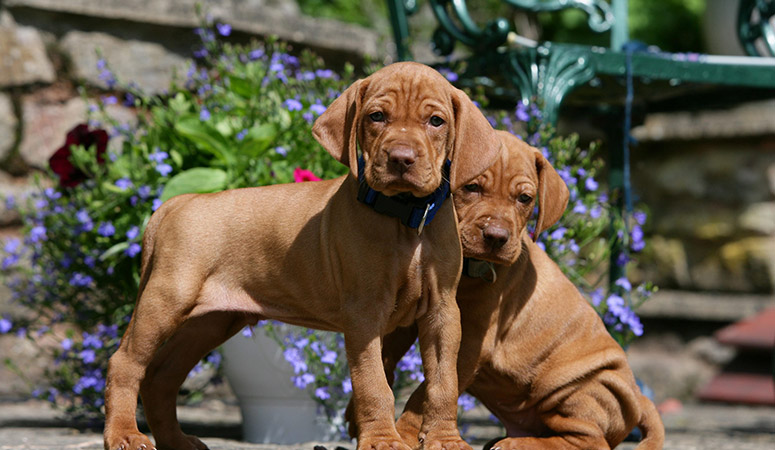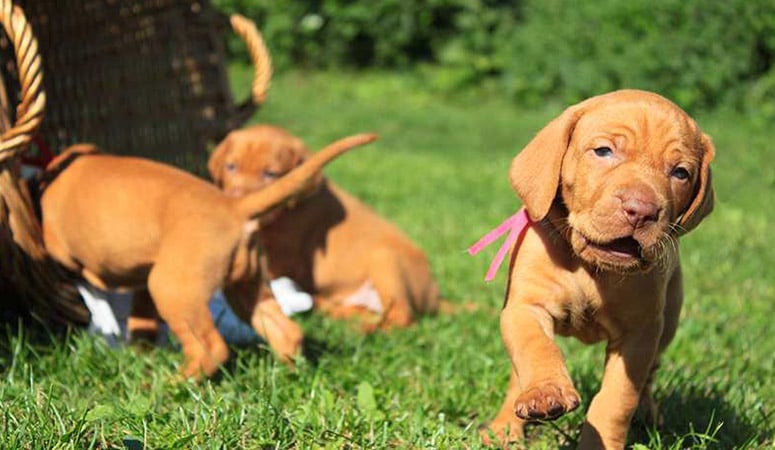Vizsla
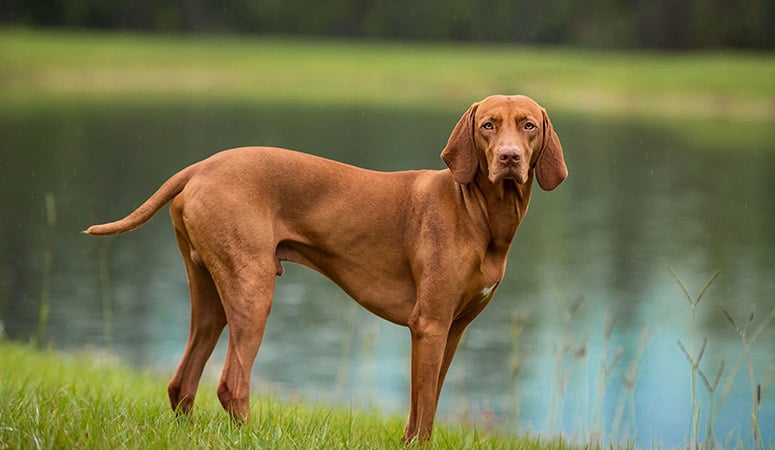
Vizslas were developed in Hungary to work as a pointer and retriever dog breed, they have a distinctive, unicolor appearance and their golden rust color is a symbol of this breed. Their gait is graceful, and the light but muscular built gives them speed and endurance in the field. You can see his athletic ability in his figure and agility.
| Other Names | Hungarian Vizsla, Magyar Vizsla, Hungarian Pointer, Drotszoru Magyar Vizsla |
| Color | Golden Rust, Golden, Red, Red Golden, Rust, Rust Golden, Sandy Yellow |
| Height | Males: 22-25 inches. Females: 21-24 inches. |
| Weight | Males: 44-66 pounds. Females: 44-66 pounds. |
| Life Span | 12-14 years |
| Personality | Affectionate, Gentle, Energetic |
| Exercise | Energetic |
| Origin |
| Popularity | #34 |
| Groom Needs | Weekly |
| Kids Friendly | Yes |
| Dog Friendly | Yes with supervision |
| Watch Dog | |
| Family Dog | |
| Litter Size | 6-7 |
Vizsla Pictures
Vizsla Video
Introduction
Originating from Hungary, this fast running dog can run very fast, topping speeds of 64-66 km; it makes sense – they have agile bodies built for athleticism, stamina, and inner strength. They weigh around 65 pounds and are 24 inches at the shoulders. They have many names actually; Hungarian Vizslas, Hungarian Pointers, Drotszoru Magyar Vizslas, and Magyar Vizslas. Their color is red-golden. They’re born with vivid blue eyes, but as they get older, they change to a very striking orange-yellow color. People are known to call the Vizsla ‘Velcro Dogs’ because they become so attached to their loved ones. They are known to love the water as well, and if you look at their feet, they are webbed, giving them a great ability in the water. They are smart and alert and need lots of activity, making great family dogs in an active household. It has a short, smooth, and sleek coat with no undercoat, so just a weekly brush is required.
Living with Vizsla
The Vizsla has a short, sleek coat with no undercoat, so it is easy to groom. Weekly brushing will keep the coat healthy and shiny, and the owner can use a dry shampoo or to rub the dog down with a wet cloth. The Vizsla need a bath only when necessary because this breed doesn’t tend to get very dirty or smelly. Usually, give it a bath once a month is enough.
Check the dog’s ears every week for dirt, wax build-up, or signs of irritation, and check them with a mild ear-cleaning product to prevent ear infection problems. Brush your dog’s teeth at least once a week to keep fresh breathe and prevent gum disease. Besides, trim the nails every few weeks if your dog doesn’t wear the toenails down naturally.
Vizslas are active hunting dogs, and they need both physical and mental exercise. They require plenty of exercise at least an hour every day which could be long walks, training sessions, and playtime. If not given enough exercise, they may be overactive and destructive.
Most Vizslas need chances to run hard off-leash on a regular basis besides leash walks and games of fetch. More importantly, mental exercise is essential as well as physical activity, so it is recommended to add the training sessions to your dog’s exercise routine.
Vizslas can be excellent running or jogging companions, but the young dogs shouldn’t allow running long distances until they reach maturity at about 18 to 24 months.
Since Vizsla is an active dog, be sure to provide it with adequate nutrition. Generally, it is recommended to feed it with three to four cups of high-quality dry dog food every day, divided into two meals. More importantly, the food amount should depend on the dog’s weight, size, age, and activity level. There should be fresh and clean water at all times.
Some dogs are easy to get overweight, so you need to watch their calorie consumption and weight level all the time. Treats may be an important aid in training, but excessive intake can lead to obesity. Also, owners need to distinguish which human food is safe for dogs and which are not. If you have any problems with your dog’s weight or diet, just consult from your veterinarian.
Vizslas are prone to the following health conditions: Epilepsy, Heart conditions, Arthritis, Progressive retinal atrophy, Hypothyroidism, allergies, hip dysplasia, cataracts, von Willebrand disease…
Major concerns: epilepsy
Minor concerns: lymphosarcoma, CHD
Occasionally seen: tricuspid valve dysplasia, PRA, persistent right aortic arch, dwarfism, hypothyroidism, vWD
Suggested tests:
Hip Evaluation
Thyroid Evaluation
Ophthalmologist Evaluation
Total Annual Cost: $2889
Cost is estimated for the first year and may vary depending on many factors, such as dog food, health care, leash, collar, licensing, possible fencing, crates, training and obedience classes, dog-walking, grooming, treats, toys, flea, tick, and heart-worm meds, microchips, etc.
Vizslas are very smart dogs and eager to please, so they could be easily trained. And the dog should get consistent and positive training from puppyhood. Early and ongoing socialization is important to make sure the dog has the confidence to enjoy various activities because it is a sensitive breed.
Besides, Vizslas can be taught to retrieve and point easily, as well as obedience, survival skills, toilet-training, and socialization with humans and other animals. They can perform well in a variety of dog sports, also can work as therapy dogs. And Vizslas enjoy the canine activities such as obedience, rally, agility, hunting tests, dock diving, and tracking.
History
The Vizsla, in Hungarian, means “Pointer”. That’s because, when it first came into existence, it would point towards the direction of its prey, allowing hunters to quickly kill the game the Vizsla had pointed out.
They are believed to have been bred by the Magyar Tribe who settled in Hungary way back in time, around 800 A.D., for hunting purposes.
After World War I, this dog nearly became extinct but was fortunately preserved by some Vizsla fanciers. In 1945, during World War II, many Hungarians fled away from the Russian occupation, not forgetting their Vizslas behind.
Around 1930, people realized these dogs weren’t suitable for hunting in the really cold snowy areas because of their short coats. Breeders started crossing the Vizsla with other dog breeds that had thick wiry coats. These were the German Wirehaired Pointers and maybe the Griffons – they produced a whole new breed which was later called the Wirehaired Vizsla.
They were imported to the USA in the 1950s, Sari was the first Vizsla to be imported and just 10 years later, the Vizsla got recognized by the American Kennel Club as being a distinct breed in 1960, ranked 33rd in the American Kennel Club registry.
One dog named Chartay became the AKC champion dog in 2000 winning amazing trophies – she was given the Vizsla Club of America Hall of Fame award for her superb versatility and excellence in several different canine sports – an unforgettable, much-loved dog, the Vizsla.
Helpful Information
Breed Club: VIZSLA CLUB OF AMERICA, INC.
Breed Club Link: https://www.vcaweb.org/
Breed Club Rescue:
Breed Club Rescue Link: https://www.vcaweb.org/rescue/contacts.shtml

